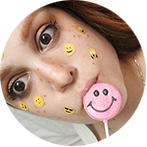







Welcome Back
Sign in to be closer to your community!
Follow other divas, like and comment
on their posts, message them, and see
who loved your posts!
Invalid username or password
You have not verified your account by clicking on the link we sent you via email. Please check your email folders (including your Spam folder) and click on the verify link sent.
Email is required
Password is required








Join FashionPotluck.com
Create your own profile in order to create content, follow other divas and like their posts, use our own messenger, and be a part of a growing international women community!
WELCOME TO OUR COMMUNITY
Fashion Potluck -
the first social media
platform for women.
You are free to read/watch & create content,
express your true self, and interact with others.
Join for free
Already a member? Log in here.
Purchase Alert
Dear Queen, you can only buy from one seller at the time. Please finish this purchase first in order to buy from another FP member
Comments
Please select one platform to continue
Please select one platform to continue
Please select one platform to continue
Please select one platform to continue
Please select one platform to continue
Please select one platform to continue
Please select one platform to continue
Please select one platform to continue
EDITOR APPROVED
You are wondering what is this 'Editor Approved'?
Well, this is pretty awesome! In order for the post to qualify and receive this accolade, it has to have a minimum of 700 words and two images (at least one original).
Receiving this accolade means two things: 1) Your content is amazing! Good job! 2) Your content qualifies for our monetization program. Every week two of the most read posts receive monetary rewards.
Have the badge & want to monetize your content?

LIFESTYLE

You may have never given much thought to your child’s teeth, but they are important for their future. A healthy set of teeth helps a child chew and speak clearly, and prevents them from developing tooth decay and other dental problems as they get older. While most children won’t experience any issues with their teeth, there are some conditions that can cause issues for your child. If you see any of the following signs in your child, it’s time to call the dentist:
1. Tooth decay
Tooth decay is caused by bacteria that grow in the gaps of your child’s teeth. It’s common in children because they aren’t brushing and rinsing their teeth as frequently as adults do. It’s important to regularly brush your child’s teeth to prevent tooth decay. If you notice any tooth decay, don’t ignore it. It is essential to contact a pediatric dentist right away. They can recommend a treatment plan that will prevent tooth decay in the future.
2. Crowding
Crowding is when one or more teeth are pushed up against the adjacent teeth. If it’s mild, it can cause only a slight change in the shape of your child’s teeth. If it’s severe, it can cause an uneven bite or teeth that are crooked. It’s best to have your child’s dentist take a look to determine if there’s any chance of the condition worsening. Your dentist may recommend a dental clearance, in which they remove a few teeth to give your child more room.
3. Gum disease
Gum disease is a serious condition caused by bacteria that attacks the soft tissues of your child’s mouth. The most common symptom is bleeding when your child brushes their teeth or chews on hard foods. Other symptoms include bad breath and increased gum swelling. It’s important to get your child’s teeth cleaned and examined at least once a year by an experienced dentist. You can also use alternative methods of oral care like mouthwash or interdental brushes.
4. Broken tooth
A tooth that has been broken off is called a displaced tooth. It usually happens as a child is chewing on a solid piece of food. The tooth gets broken, but the jawbone that it’s attached to holds it in place. A displaced tooth may cause a bad bite, increased pain when chewing tough foods, and even infection. It’s best to have your child’s dentist examine and treat any broken teeth right away. Sometimes, the tooth can be saved if it’s still attached to a healthy tooth. If the tooth is no longer attached to any other teeth, it’s time to get it removed.
5. An abscess or inflammation in the jawbone
When plaque and bacteria collect on the root surfaces of your child’s teeth, it can lead to an abscess or inflammation in the jawbone. If it’s an abscess, the area around the tooth becomes swollen and painful. An abscess can cause your child to have difficulty eating certain foods and drinking liquids. It’s important to get your child’s teeth cleaned and examined regularly by your pediatric dentist. You can also brush your child’s teeth with a toothbrush designed for kids.
6. Soft-tissue injury in the mouth
Crowns and dental bridges are designed to protect your child’s teeth and help them chew and speak clearly. However, sometimes these dental products cause soft tissue damage. It usually happens when your child is young and new to dental treatment. If your child complains of pain while chewing or drinking liquids, it may be a sign of a dental injury caused by a crown or bridge. It’s important to get your child’s dental treatment checked out by a dentist as soon as possible.
Comments
Related Posts
- Mumbai Escorts by Neha Mari 0
- What Makes Men’s Accessories Worth Investing In Today? by Ekim Fashion 0
- How to Plan Seasonal Plush Inventory Without Overbuying by Harnel Inc 0
More Posts
- Affordable Embroidery Services | Free Design Assistance by Embroidery Designs 0
- Beyond the Hardwood: Finding the Fun in Absurd Physics Games like Basket Random by Suzanna Brown 0
- Why Cowboy Ties Are Making a Bold Fashion Comeback This Year by Rocky Mountain Western 0
Vote content out
Reason for voting this content out?
Reason for voting this content out?


 Login with Google
Login with Google Login with Twitter
Login with Twitter






 by
by
Add Comments